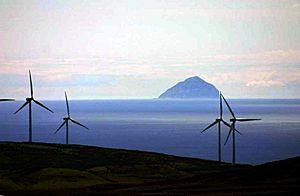Energy policy of Scotland facts for kids
Energy policy in Scotland is mostly decided by the UK Parliament. However, the Scottish Government can approve or refuse new energy projects. This means they can help shape how Scotland gets its power.
In 2004, a group in the Scottish Parliament suggested that Scotland should have its own full energy plan. When the Scottish National Party (SNP) government took power in 2007, they created a new job called the 'Minister for Enterprise, Energy and Tourism'. This showed how important energy had become to them.
Contents
Scotland's Energy Sources
Scotland used to make electricity from coal. However, the last coal power station, Longannet power station, closed in March 2016. This means Scotland no longer uses coal to produce electricity.
Renewable Power in Scotland
Scotland has amazing natural resources for renewable energy. This includes power from wind, waves, and tides. These sources are among the best in Europe and even the world.
By the end of 2011, Scotland had enough renewable energy sources to produce 4,796 megawatts of electricity. This was a big increase from 2010. In 2011, renewable energy made up about 35% of Scotland’s electricity. This was more than the Scottish Government's goal of 31%. Scotland also produced almost 40% of the UK's renewable energy that year.
Making energy from renewable sources is getting better and cheaper. People are also worried about "peak oil" (when oil production starts to drop) and climate change. These worries are encouraging more use of biofuels and other green energy.
Many projects are being planned to increase renewable energy. There are also plans to reduce carbon emissions. Most people support these efforts. However, some worry about how new energy technologies might affect the natural environment. There is also a discussion about who should own and control these energy sources.
There is an ongoing debate about how to encourage more renewable energy in Scotland. Some people think that the UK government should recognize that it costs more to build renewable energy projects in Scotland than in England.
Nuclear Power in Scotland
The UK Government looked into energy options in 2006. At that time, the Scottish National Party (SNP) said that Scotland did not need new nuclear power stations.
By January 2008, the UK Government decided to build new nuclear power stations across the UK. However, the SNP was then in charge of the Scottish Government. First Minister Alex Salmond stated that there was "no chance" of new nuclear power stations being built in Scotland. The Scottish Parliament agreed with this decision, voting 63 to 58 against new nuclear power.
Beauly-Denny Power Line Upgrade
A major project was proposed to upgrade an electricity line. This line would run from Beauly, near Inverness, to Denny, near Falkirk. The upgrade was seen as very important for future energy growth.
The project faced delays for three years due to planning issues. Some people strongly opposed it, while others strongly supported it. The main concern was how the large power pylons would look near the Cairngorms National Park. To help with this, 53 kilometers of an older, smaller power line inside the park were removed and not replaced.
In 2008, a study confirmed that upgrading the Beauly-Denny power line was key to meeting Scotland's renewable energy goals. In January 2010, the Scottish Government approved the upgrade. The new power line started working by Christmas 2015.
See also
- North Sea oil
- Nuclear power in Scotland
- Renewable energy in Scotland


